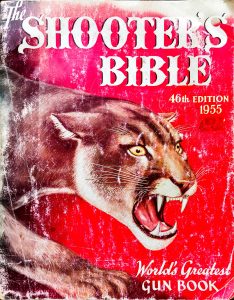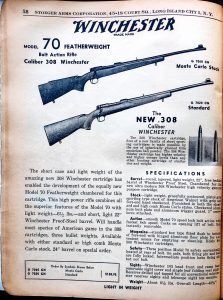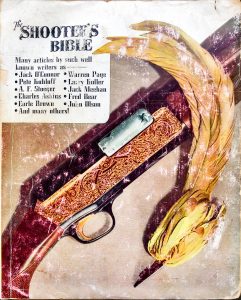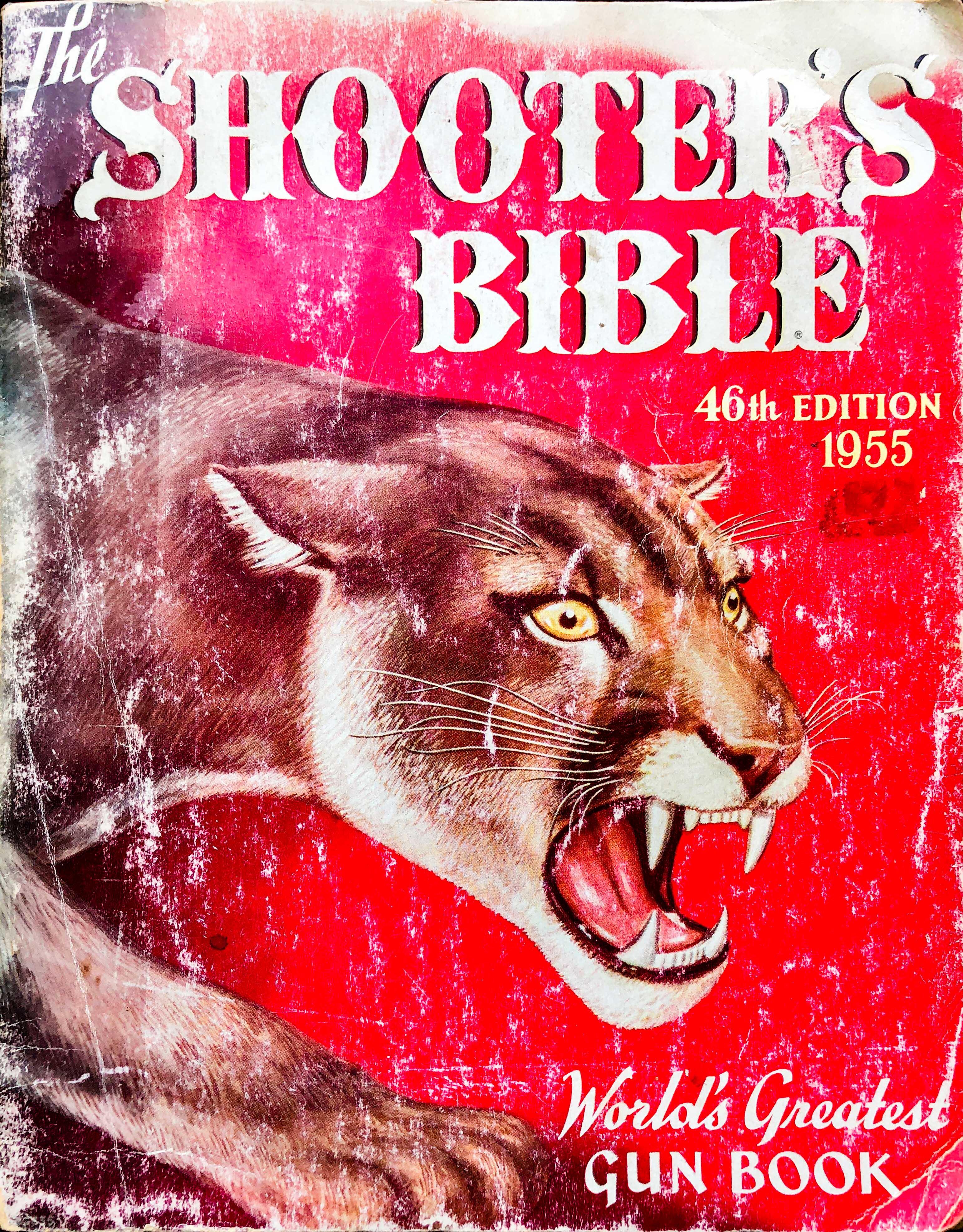After all the grimness we’ve recently discussed here, it’s time for some good old gun stuff. At one of the Half Price Books stores, I recently picked up a well-thumbed copy of Stoeger’s Shooter’s Bible from 1955. ’55 was a rich year for newly introduced guns that would become classics of their time.
1955 was the year that the first newsstand gun magazine, Guns, came out. I was seven years old, and in Corner Pharmacy across the street from my dad’s jewelry store, it sucked my eye right off the comic book rack. Not in my wildest dreams would I have thought I’d end up being Handgun Editor of that publication for about 40 years, right up to present times.
When I was a very little boy, the most memorable tome on the bookshelf in my bedroom was a 1947 Shooter’s Bible that my father had purchased the year I was born, and I imprinted on the thing like a little duckling on a momma duck. You have to remember that back then, gun periodicals were annual, not monthly, and there were only two games in town: Gun Digest and Shooter’s Bible. Each was part catalog of firearms and accessories then available, and articles from the firearms gurus of the time.
The 1955 edition, the 46th, had articles by many of the greats: Charles Askins, Fred Bear, Pete Kuhlhoff, Jack O’Connor, Warren Page, and more. Askins, the only one of those I ever got to meet and become friends with in later years, did a piece called “Handgun Hotshot In One Easy Lesson,” in which the former national pistol champion postulated that “Trigger control is 99% of the art, the other fundamentals shape up the remainder of the 100%.” The decades since taught me that while I wouldn’t go as high as 99%, trigger control was indeed The Heart of the Beast for accurate shooting.
Jack O’Connor wrote “The Battery for the African Safari” in which he suggested the .375 Holland & Holland Magnum for someone taking only one rifle for all game including the dangerous stuff, with something bigger preferred for elephant and something on the order of a .30-06 recommended for plains game. It proved to be timeless advice. A little over a quarter of a century thereafter, when I took a .308, a .375, and a .458 on my first African safari all my needs were met, and a year later I found a .375 and a .270 to suffice for my second and last safari there.
When we look at the old gun catalogs, we tend to drool too much over yesteryear’s prices. Let’s have some perspective. Average income for an American household in 1955 was around $5,000, per the yesiamcheap.com cost of living website. That comes out to $96.15 a week; today, it’s reportedly ten times that at least, which rounds off to a little under a thousand a week.
The Winchester section highlighted the 6.5-pound Model 70 Featherweight bolt action hunting rifle, in caliber .308 Winchester, both newly introduced. The Featherweight ran $120.95, well over a week’s income for the typical American family in 1955. If you want an equally accurate bolt-action .308 about as light for hunting today, the Ruger All-American is $489 MSRP, and almost half a pound lighter than the old Winchester Model 70 Featherlight…and, accounting for inflation, a helluva lot cheaper.
Going brand to brand, in 1955 Colt charged $64.60 for what they called their “Government Model .45 Automatic Pistol.” Today’s direct descendant, the Colt 1991, now carries the MSRP of $799, only slightly over the usual 10:1 ratio of inflation from 1955 to now. In shotguns, a Remington 870 in the 1955 Gun Bible started at $77.50, while today’s Remington 870 Express is an inflation-beating $417 baseline MSRP.
We also have to remember that this catalog with a 1955 title was put together the previous year. Some of the great introductions of 1955 were not listed: the iconic Colt Python revolver, Smith & Wesson’s .44 Magnum later known as the Model 29 and their ground-breaking Model 39 9mm semiautomatic, and Remington’s Model 740 .30-06 semiautomatic hunting rifle which along with its descendants like the 742, etc. were destined to be hugely popular among sportsmen.
The past was indeed prologue, in many ways. I am reminded of something my friend and fellow gun writer John Taffin has said more than once: “The Golden Age of Firearms is now!”
A blast from the past.

The .308 Winchester cartridge, and the Featherweight version of Winchester’s Model 70 rifle, were both new in 1955.

Shooter’s Bible hosted some of the best writers of the mid-20th Century.




“The Golden Age of Firearms is now!” is an accurate statement. There is no time in the past when you could purchase the myriad of firearms and accessories available today. I remember back in the 1980’s wishing that some gizmo was available for some shooting problem. Well, today many of those solutions exist. The best part is that all the modern stuff co-exists nicely with all the vintage gear.
The only thing missing is the following: I remember when you could order any firearm out of a Herter’s catalog and have it delivered to your front door as easily as a new fishing rod. We’ll never see those days again.
Thanks Uncle Mas, now I feel really old! But, those prices….heartbreaking.
I didn’t have gun mags or books, but my Marine Corps uncles had left me with copies of the “Guidebook for Marines” and “Get Tough” by W.E. Fairbairn, both of which I read and re-read to literal shreds.
Yes, I too honed my interest in firearms by reading all of the back issues of the American Rifleman (before 1968) and other “gun magazines” from the stacks in the library. The NRA hired great technical editors in those post-WWII years. Elmer Kieth was my favorite. I shot only handloaded 30-’06 in 1903 Springfield rifles and 38 S&W Special wadcutters in S&W revolvers, plus 22 LR of course. I still have my first “benchrest” rifle, an FN Mauser single-shot bolt-action with a heavy 30-’06 barrel fitted by G. R. Douglas. The FN action shows many little diamond penetrator marks from when GR was collecting Rockwell-C hardness data for one of his last articles.
Thanks for the excellent walk down Memory Lane.
We are indeed in the Golden Age of Firearms. When something is close to perfection, it is about to become obsolete. The best sail boats were invented when steam boats were making their debut. IBM Selectric 2 & 3 typewriters were state-of-the-art when the first word processors were introduced. I think that was about 1981. So when are we going to have handheld lasers or phasers? Just kiddin’!
I’m sure our old-fashioned firearms will never be obsolete. They still make and use bayonets, don’t they?
Hmmm. Imagine a drone with a laser on it. The Air Force has big planes with lasers in the nose cone, but they require a lot of energy.
In 1957, my dad purchased a Browning Auto-5 Sweet 16. I believe he said he paid $230.00 brand new then.
Sorry, Mas, but the “grimness” just won’t go away.
There was another multiple shooting today in Maryland. See this link:
http://start.att.net/news/read/article/the_associated_press-sheriffs_office_multiple_injuries_at_office_park_s-ap-2
Two (2) things jump out from this news story. First, this shooting happened in Maryland which is practically the “buckle” of the Northeast, Leftist gun prohibition belt. Maryland has most of the anti-gun type laws that make the gun-grabbers leap for joy.
Second, the shooter in this case was a known felon with over 40 arrests on his record and who, under Federal law much less Maryland State law, should have never been able to own or even touch a handgun.
Yet, as clearly shown, he did get his hands on one and has now added multiple murders to his offenses. This event clearly illustrates the complete and utter failure of firearms prohibition as a strategy to prevent violence. Yet, it is likely that the gun-grabbers will claim that it only illustrates the need for yet more gun control laws!
One definition of insanity: Doing the same thing over and over and over and over and over again while expecting a different result this time.
The other day I came across a free copy of “Elmer Keith’s Big Game Hunting,” copyright 1948. I think I must have read it about 40 years ago. A dated book, but never obsolete. Time to read it again! I knew a woman who was acquainted with Elmer through working pack hunts in Montana or Idaho, and always said that Elmer was a BS’r, but his sharing of his vast experience with firearms and hunting is the best wilderness survival guide that I have ever encountered. All these years, though, I have not found the take-down .45-70 lever-action of quality, hard steel that I would like to own.
Lets also remember that the 870 today looks like it came out of a plumbing shop. That Rem has a Billion dollar debt and is desparate to sell guns after multiple debacles. That thenPony is a shadow of what it was.That “modern” gunmakers have put lots of gun maker families out of work. That a huge segment of market involves the business profit flowing overseas. There is a reason a Python today brings a couple of grand.
Just standing up for the past when America was a real nation. I will take 1955 over today in a heartbeat. Fiberglass is not walnut. Bad guys and birds still met their fate to 1955 guns.
What’s not to like about plastic frame guns with stamped pot metal internal parts that have no soul? Many young guys who don’t know any better sure love ’em, and since they’re a major (and growing) customer base firearms manufacturers pander to them with plastic junk guns.
And the rest of us who want real guns made of quality steel? We don’t matter.
Spencer – I must agree with you about modern firearms.
They remind me of plastic plates. You know, plastic plates are really very practical. They are lightweight. They won’t shatter if you drop them on the floor. They are cheap to make and cheap to buy. They clean up fairly easy in the dishwasher. You can pop them into the microwave to heat food and it works just fine.
Yes Sir, plastic plates are very functional and practical. However, eating off of plastic plates will never give you the ambiance that you receive when you eat off of fine china. 🙂
Modern plastic firearms are similar. They are very functional, practical and cost-effective to build. However, they can never give me the same ambiance as when I hold a fine Colt Python, top-of-the-line Smith & Wesson revolver, or fine bolt-action rifle made of genuine walnut and blued steel.
A blast from the past. Things move on, sometimes better, sometimes for worse, but move on they do.
Which reminds me, I picked up a copy of ‘Fighting Handguns’ by Jeff Cooper, circa 1958, from a charity shop the other day. It was an odd sort of nostalgia, for a world I never knew, and -possibly- wouldn’t have fitted in with if I had been around then. But it was kind of interesting to read about Colt Pythons having a list price of $125, and interesting to note that Jeff Cooper’s opinions written in 1958 didn’t seem to differ much from those written in 2006. (That’s just an observation btw.)
I also have a copy of Cooper’s “Fighting Handguns”. If one takes the 1958 price of $125 and adjusts it for inflation, then it works out to be $1068 in 2017 dollars. I checked Gun Broker and found a 1964 era, 6-in blued Python (very similar to what Cooper priced in 1958) for sale. The “Starting” price was $2,599.99! The offered gun was in good shape but it was not “New in the box”. So, buying a Python back when they were affordable would have been a good investment! It would have gained well over inflation.
You are right that Cooper’s opinions were largely set by 1958. His love of the 1911 in .45 acp was already clear. However, I did notice one change from his early opinions. In 1958, Cooper largely followed the fashion of the era and emphasized one-handed “Point Shooting” in combat. After 1958, he developed his “Modern Technique” which emphasized using a two-handed hold, weaver stance and the use of sights even for close combat work. So, although Cooper’s opinions were 90% formed by 1958, he was still capable of growth and change in later life if he thought that the “pay-off” of the change was worth it.
One more addendum about “Fighting Handguns”. At the very end of this book, Cooper has a short section entitled “Pistols and the Law”. This is really a discussion about Firearms Prohibition (AKA Gun Control). In it. Cooper lists (as he sees them) the Left-wing justifications for Firearms Prohibition. Cooper then proceeds to refute them one by one.
What is interesting about this section is it’s applicability to current events. If this section was posted on the Internet as “fresh” commentary on the gun control issue, it would be just as applicable today as in 1958. In other words, in the almost 60 years since Cooper wrote these words, the ideological nature of the gun control debate as not change one iota. The firearms made today (except for the eternal 1911) are largely different, their prices and market conditions are different, shooting techniques are different, concealed carry laws have been vastly revised, but the pro-gun / anti-gun arguments remain set in concrete.
This shows the inflexibility of political orientation. It shows how resistant it is to argument, reason and debate. It is one more bit of evidence that points (as I noted in my previous post in the “How Gun Prohibitionists Think” blog) to political orientation being set at the subconscious level rather than in the rational and logical section of the human mind.
I remember those days too. I never saw a copy of Shooter’s Bible until I reached adulthood, but I remember the ads in Boys Life Magazine for Daisy and Crossman, Remington, Winchester and Marlin. There was something almost sensual about those ads, and I dreamed about getting a .22. It took almost a decade for me to reach that goal.
.22s were $10 a brick, and we could walk to the sandpit in town, and shoot all day.
Those were the days.
Thanks for putting those gun prices in perspective. What’s different about gun prices is how so many you mentioned have appreciated in value 10x, even with average use. I’ve always considered putting money into guns as a different kind of bank, and someday, we will be looking at this years gun digest and saying “Why didn’t I buy it then?”
For many years the Shooter’s Bible was my Christmas present to my dad. I got many hours of enjoyment studying it as well.
Thanks for the reality check. 🙂
Comments are closed.